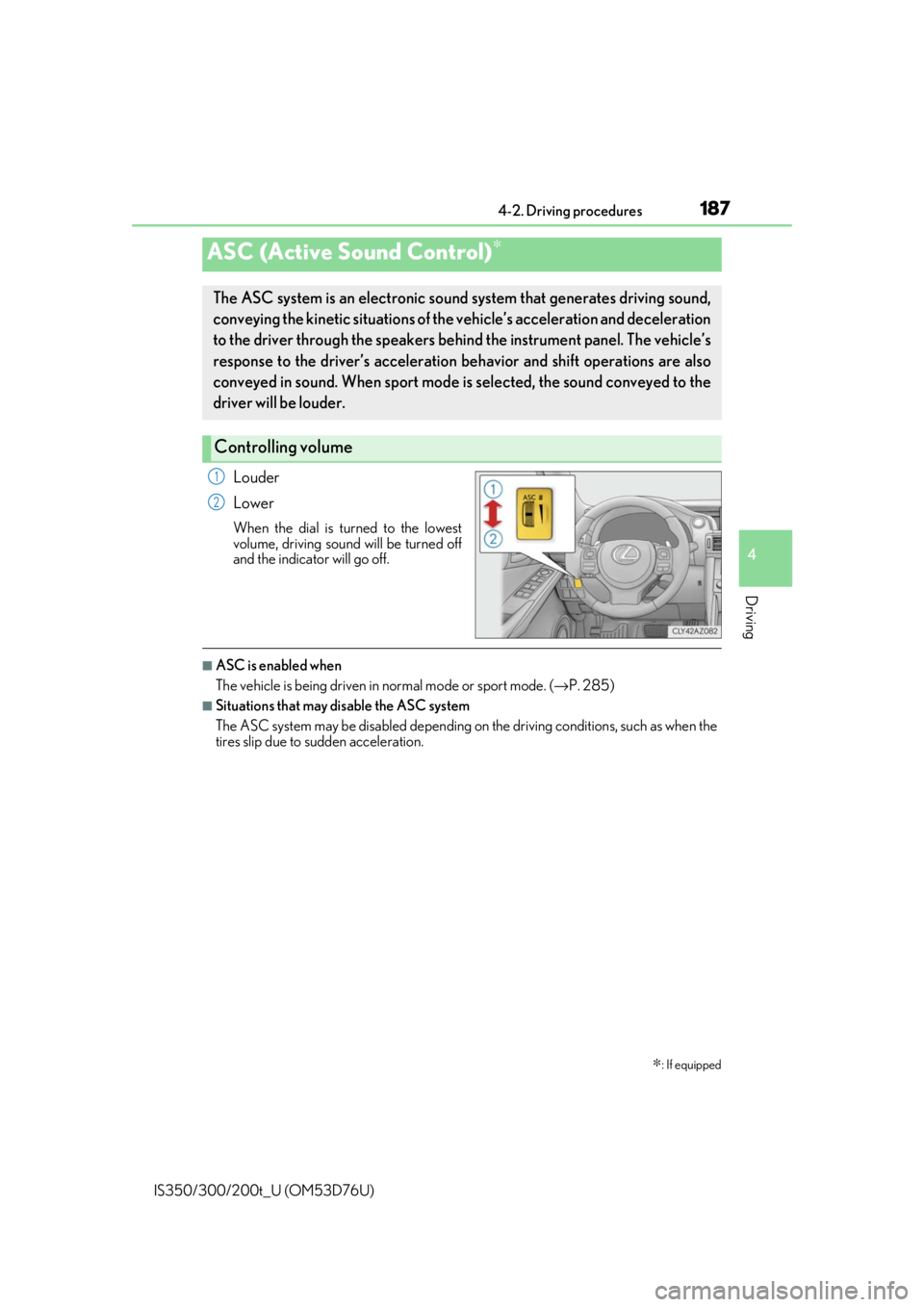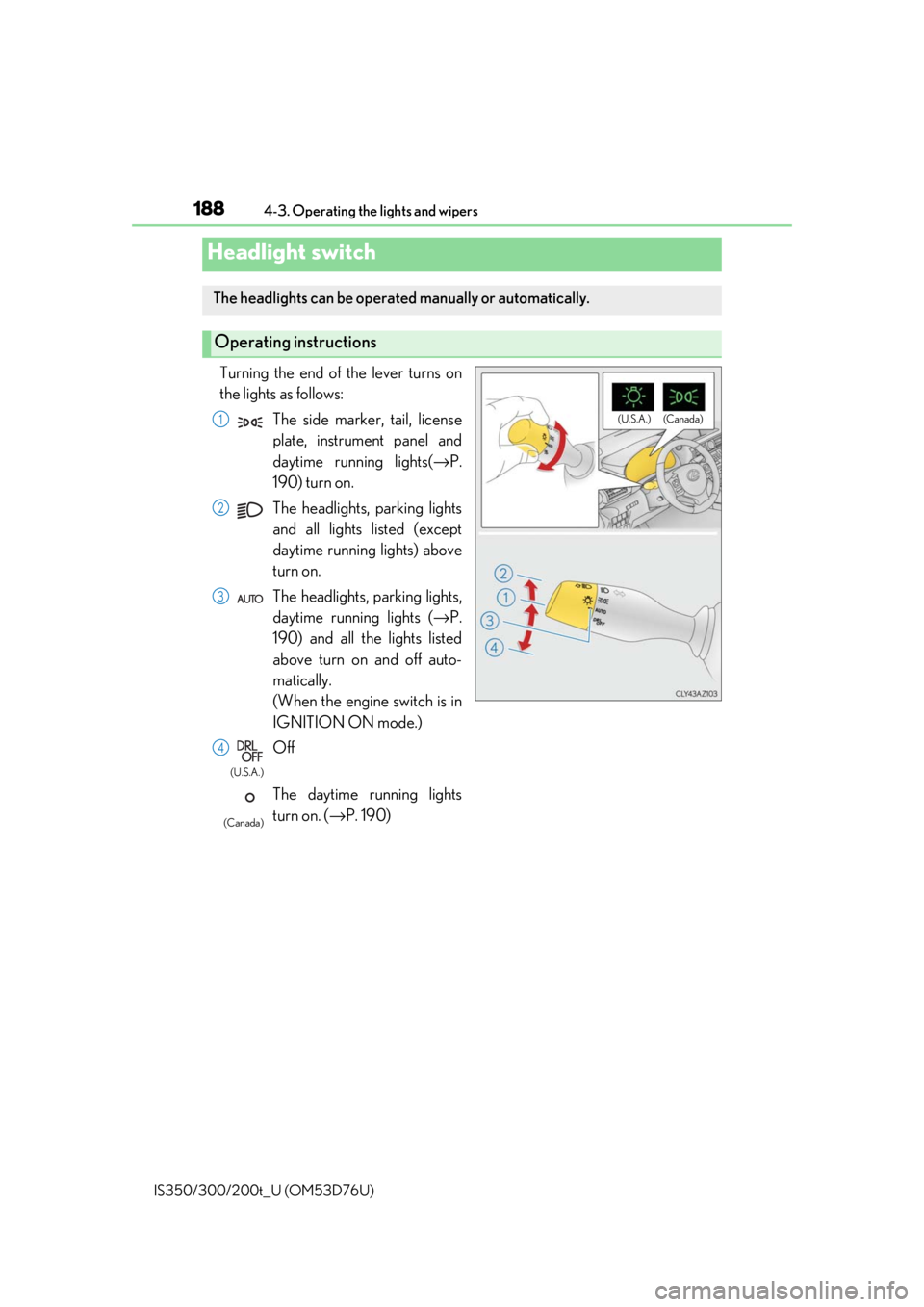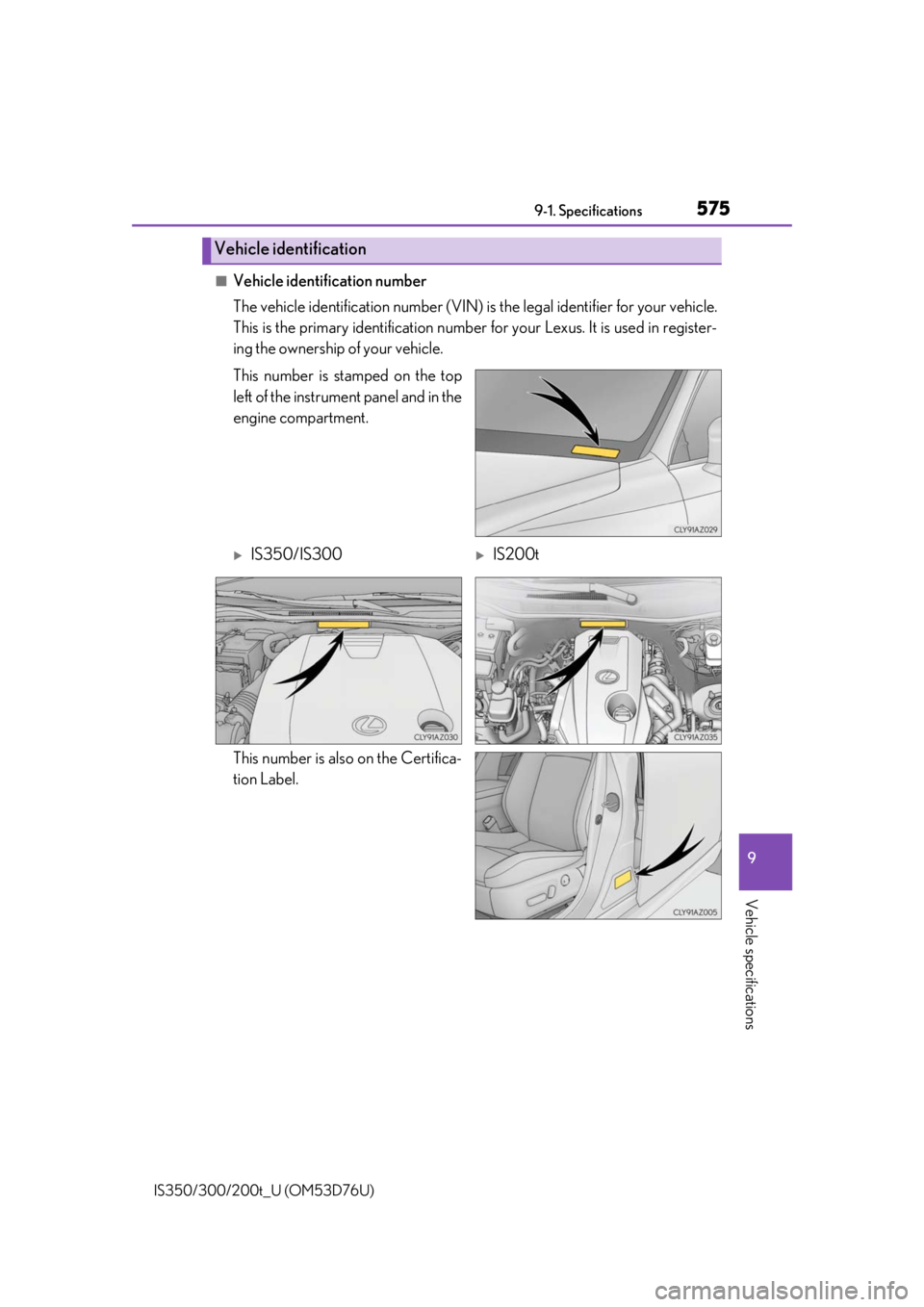instrument panel Lexus IS300 2017 / LEXUS 2017 IS200T,IS300,IS350 (OM53D76U) User Guide
[x] Cancel search | Manufacturer: LEXUS, Model Year: 2017, Model line: IS300, Model: Lexus IS300 2017Pages: 648, PDF Size: 10.73 MB
Page 125 of 648

1253-2. Opening, closing and locking the doors and trunk
3
Operation of each component
IS350/300/200t_U (OM53D76U)
■Note for the entry function
●Even when the electronic key is within the effective range (detection areas), the system
may not operate properly in the following cases:
• The electronic key is too close to the window or outside door handle, near the ground, or in a high place when the doors are locked or unlocked.
• The electronic key is near the ground or in a high place, or too close to the rear
bumper center when the trunk is opened.
• The electronic key is on th e instrument panel, rear pack age tray or floor, or in the
door pockets or glove box when the engine is started or engine switch modes are
changed.
●Do not leave the electronic key on top of th e instrument panel or near the door pockets
when exiting the vehicle. Depending on the radio wave reception conditions, it may be
detected by the antenna outside the cabin an d the doors will become lockable from the
outside, possibly trapping the electronic key inside the vehicle.
●As long as the electronic key is within th e effective range, the doors may be locked or
unlocked by anyone. However, only the door s detecting the electronic key can be used
to unlock the vehicle.
●Even if the electronic key is not inside the vehicle, it may be possible to start the engine
if the electronic key is near the window.
●The doors may unlock or lock if a large amou nt of water splashes on the door handle,
such as in the rain or in a car wash, when th e electronic key is within the effective range.
(The doors will automatically be locked after approximately 30 seconds if the doors
are not opened and closed.)
●If the wireless remote control is used to lo ck the doors when the electronic key is near
the vehicle, there is a possibility that the d oor may not be unlocked by the entry func-
tion. (Use the wireless remote control to unlock the doors.)
●Touching the door lock or unlock sensor while wearing gloves may prevent lock or
unlock operation.
●When the lock operation is performed using the lock sensor, recognition signals will be
shown up to two consecutive times. After this, no recognition signals will be given.
●If the door handle becomes wet while the el ectronic key is within the effective range,
the door may lock and unlock repeatedly. In this case, follow the following correction
procedures to wash the vehicle:
• Place the electronic key in a location 6 ft. (2 m) or more away from the vehicle. (Take care to ensure that the key is not stolen.)
• Set the electronic key to battery-saving mode to disable the smart access system with push-button start. ( →P. 123)
●If the electronic key is inside the vehicle and a door handle becomes wet during a car
wash, a message may be shown on the mult i-information display and a buzzer will
sound outside the vehicle. To turn off the alarm, lock all the doors.
●The lock sensor may not work properly if it comes into contact with ice, snow, mud, etc.
Clean the lock sensor and attempt to operate it again, or use the lock sensor on the
lower part of the door handle.
●A sudden handle operation or a handle operation immediately after entering the effec-
tive range may prevent the doors from bein g unlocked. Touch the door unlock sensor
and check that the doors are unlocked before pulling the door handle again.
●Unlocking the vehicle may take more time if another electronic key is within the effec-
tive range.
Page 163 of 648

1634-1. Before driving
4
Driving
IS350/300/200t_U (OM53D76U)
WARNING
Observe the following precautions.
Failure to do so may result in death or serious injury.
■When the vehicle is stopped
●Do not race the engine.
If the shift lever is any position other than P or N, the vehicle may accelerate suddenly
and unexpectedly, causing an accident.
●In order to prevent accidents due to the ve hicle rolling away, always keep depressing
the brake pedal while the engine is running, and apply the parking brake as neces-
sary.
●If the vehicle is stopped on an incline, in order to prevent accidents caused by the
vehicle rolling forward or backward, alwa ys depress the brake pedal and securely
apply the parking brake as needed.
●Avoid revving or racing the engine.
Running the engine at high speed while the vehicle is stopped may cause the exhaust
system to overheat, which could result in a fire if combustible material is nearby.
■When the vehicle is parked
●Do not leave glasses, cigarette lighters, sp ray cans, or soft drink cans in the vehicle
when it is in the sun.
Doing so may result in the following:
• Gas may leak from a cigarette lighter or spray can, and may lead to a fire.
• The temperature inside the vehicle may cau se the plastic lenses and plastic mate-
rial of glasses to deform or crack.
• Soft drink cans may fracture, causing the contents to spray over the interior of the
vehicle, and may also cause a short circui t in the vehicle’s electrical components.
●Do not leave cigarette lighters in the vehicle. If a cigarette lighter is in a place such as
the glove box or on the floor, it may be lit accidentally when luggage is loaded or the
seat is adjusted, causing a fire.
●Do not attach adhesive discs to the windsh ield or windows. Do not place containers
such as air fresheners on th e instrument panel or dashboard. Adhesive discs or con-
tainers may act as lenses, ca using a fire in the vehicle.
●Do not leave a door or window open if th e curved glass is coated with a metallized
film such as a silver-colored one. Reflecte d sunlight may cause the glass to act as a
lens, causing a fire.
●Always apply the parking brake, shift the shift lever to P, stop the engine and lock the
vehicle.
Do not leave the vehicle unattend ed while the engine is running.
If the vehicle is parked with the shift leve r in P but the parking brake is not set, the
vehicle may start to move, possibly leading to an accident.
●Do not touch the exhaust pipes while the engine is running or immediately after turn-
ing the engine off.
Doing so may cause burns.
Page 168 of 648

1684-1. Before driving
IS350/300/200t_U (OM53D76U)
WARNING
■Things that must not be carried in the trunk
The following things may cause a fire if loaded in the trunk:
●Receptacles containing gasoline
●Aerosol cans
■Storage precautions
Observe the following precautions.
Failure to do so may prevent the pedals from being depressed properly, may block the
driver’s vision, or may result in items hittin g the driver or passengers, possibly causing
an accident.
●Stow cargo and lugg age in the trunk whenever possible.
●To prevent cargo and luggage from sliding forward during braking, do not stack any-
thing in the enlarged trunk. Keep cargo and luggage low, as close to the floor as pos-
sible.
●When you fold down the rear seats, long items should not be placed directly behind
the front seats.
●Never allow anyone to ride in the enlarged trunk. It is not designed for passengers.
They should ride in their seats with their seat belts properly fastened.
●Do not place cargo or luggage in or on the following locations.
• At the feet of the driver
• On the front passenger or re ar seats (when stacking items)
• On the package tray
• On the instrument panel
•On the dashboard
• In front of the Lexus Display Audio scre en (if equipped) or navigation system
screen (if equipped)
●Secure all items in the occupant compartment.
■Capacity and distribution
●Do not exceed the maximum axle weight rating or the total vehicle weight rating.
●Even if the total load of occupant’s weight and the cargo load is less than the total load
capacity, do not apply the load unevenly. Improper loading may cause deterioration
of steering or braking control whic h may cause death or serious injury.
Page 187 of 648

1874-2. Driving procedures
4
Driving
IS350/300/200t_U (OM53D76U)
Louder
Lower
When the dial is turned to the lowest
volume, driving sound will be turned off
and the indicator will go off.
■ASC is enabled when
The vehicle is being driven in normal mode or sport mode. (→P. 285)
■Situations that may disable the ASC system
The ASC system may be disabled depending on the driving conditions, such as when the
tires slip due to sudden acceleration.
ASC (Active Sound Control)∗
∗
: If equipped
The ASC system is an electronic sound system that generates driving sound,
conveying the kinetic situations of the vehicle’s acceleration and deceleration
to the driver through the speakers behi nd the instrument panel. The vehicle’s
response to the driver’s acceleration behavior and shift operations are also
conveyed in sound. When sport mode is selected, the sound conveyed to the
driver will be louder.
Controlling volume
1
2
Page 188 of 648

188
IS350/300/200t_U (OM53D76U)4-3. Operating the lights and wipers
Headlight switch
The headlights can be operated
manually or automatically.
Operating instructions
(U.S.A.) (Canada)
Turning the end of the lever turns on
the lights as follows:
The side marker, tail, license
plate, instrument panel and
daytime running lights( →P.
190) turn on.
The headlights, parking lights
and all lights listed (except
daytime running lights) above
turn on.
The headlights, parking lights,
daytime running lights ( →P.
190) and all the lights listed
above turn on and off auto-
matically.
(When the engine switch is in
IGNITION ON mode.)
Off
The daytime running lights
turn on. ( →P. 190)
1
2
3
4
(U.S.A.)
(Canada)
Page 409 of 648

4096-2. Using the air conditioning system
6
Interior features
IS350/300/200t_U (OM53D76U)
■When the outside temperature falls to nearly 32°F (0 °C)
The dehumidification function may not oper ate even when is pressed or “A/C” is
selected.
■Ventilation and air conditioning odors
●To let fresh air in, set the air conditioning system to the outside air mode.
●During use, various odors from inside and outside the vehicle may enter into and accu-
mulate in the air conditioning system. This may then cause odor to be emitted from the
vents.
●To reduce potential odors from occurring:
• It is recommended that the air conditioning system be set to outside air mode prior
to turning the vehicle off.
• The start timing of the blower may be dela yed for a short period of time immediately
after the air conditioning system is started in automatic mode.
■Air conditioning filter
→P. 491
■Customization
Settings (e.g. A/C Auto switch operation) can be changed.
(Customizable features: →P. 608)
WARNING
■To prevent the windshield from fogging up
●Do not use during cool air operation in extremely humid weather. The differ-
ence between the temperature of the outside air and that of the windshield can cause
the outer surface of the windshield to fog up, blocking your vision.
■To prevent burns
●Do not touch the rear view mirror surfaces when the outside rear view mirror defog-
gers are on.
●Do not touch the glass at lower part of the windshield or to the side of the front pillars
when the windshield wiper de-icer is on.
NOTICE
■To prevent battery discharge
Do not leave the air conditioni ng system on longer than necessary when the engine is
stopped.
●Do not place anything on the instrument
panel which may cover th e air outlets. Other-
wise, air flow may be obstructed, preventing
the windshield defoggers from defogging.
Page 451 of 648

4517-1. Maintenance and care
7
Maintenance and care
IS350/300/200t_U (OM53D76U)
■Caring for leather areas
Lexus recommends cleaning the interior of the vehicle at least twice a year to maintain
the quality of the vehicle’s interior.
■Shampooing the carpets
There are several commercial foaming-type cleaners available. Use a sponge or brush to
apply the foam. Rub in overlapp ing circles. Do not use water. Wipe dirty surfaces and let
them dry. Excellent results are obtained by keeping the carpet as dry as possible.
■Seat belts
Clean with mild soap and lukewarm water using a cloth or sponge. Also check the belts
periodically for excessive wear, fraying or cuts.
■When cleaning the carpeted portions of the glove box, console box, etc.
If a strong adhesive tape is used, there is a possibility that the surface of the carpet could
be damaged.
WARNING
■Water in the vehicle
●Do not splash or spill liquid in the vehicle.
Doing so may cause electrical components etc. to malfunction or catch fire.
●Do not get any of the SRS components or wiring in the vehicle interior wet.
( → P. 37)
An electrical malfunction ma y cause the airbags to deploy or not function properly,
resulting in death or serious injury.
■Cleaning the interior (especially instrument panel)
Do not use polish wax or polish cleaner. Th e instrument panel may reflect off the wind-
shield, obstructing the driver’s view and le ading to an accident, resulting in death or
serious injury.
Page 495 of 648

4957-3. Do-it-yourself maintenance
7
Maintenance and care
IS350/300/200t_U (OM53D76U)
Turn the engine switch off.
Open the Fuse box cover.
Checking and replacing fuses
If any of the electrical components do not operate, a fuse may have blown. If
this happens, check and replace the fuses as necessary.
1
2
Engine compartment (type A fuse
box)
Push the tab in and lift the lid off.Engine compartment (type B fuse
box)
Push the tab in and lift the lid off.
Driver’s side instrument panel
Remove the lid.
Page 575 of 648

5759-1. Specifications
9
Vehicle specifications
IS350/300/200t_U (OM53D76U)
■Vehicle identification number
The vehicle identification number (VIN) is the legal identifier for your vehicle.
This is the primary identification number fo r your Lexus. It is used in register-
ing the ownership of your vehicle.
This number is stamped on the top
left of the instrument panel and in the
engine compartment.
This number is also on the Certifica-
tion Label.
Vehicle identification
IS350/IS300IS200t
Page 632 of 648

632Alphabetical index
IS350/300/200t_U (OM53D76U)
Back-up lightsReplacing light bulbs ....................... 502
Battery....................................................... 473 Battery checking ................................ 473
If the vehicle battery is discharged.....................................562
Preparing and checking before winter ....................................................294
Warning light ........................................ 516
Bluetooth
®
Audio system ...................................... 358
Hands-free system (for cellular phone) ....................... 359
Bottle holders ........................................... 417
Brake Fluid........................................................... 472
Parking brake........................................ 186
Warning light ........................................ 516
Brake assist ............................................. 289
Break-in tips............................................. 159
Brightness control Instrument panel light control ......... 82
BSM (Blind Spot Monitor)................ 273 Blind Spot Monitor function ......... 277
Rear Cross Traffic Alert function ............................................... 280 Care................................................ 446, 450
Aluminum wheels .............................. 447
Exterior ................................................... 446
Interior .....................................................450
Seat belts..................................................451
Cargo capacity ....................................... 169
Cargo hooks ............................................ 419
CD player................................................ 332
Chains ....................................................... 295
Child restraint system ........................... 53 Booster seats, definition .................... 54
Booster seats, installation ................. 63
Convertible seats, definition ........... 54
Convertible seats, installation......... 60
Front passenger occupant classification system......................... 46
Infant seats, definition.......................... 54
Infant seats, installation....................... 60
Installing CRS with LATCH anchors ..................... 58
Installing CRS with seat belts ......... 60
Installing CRS with top tether strap......................... 64
BC